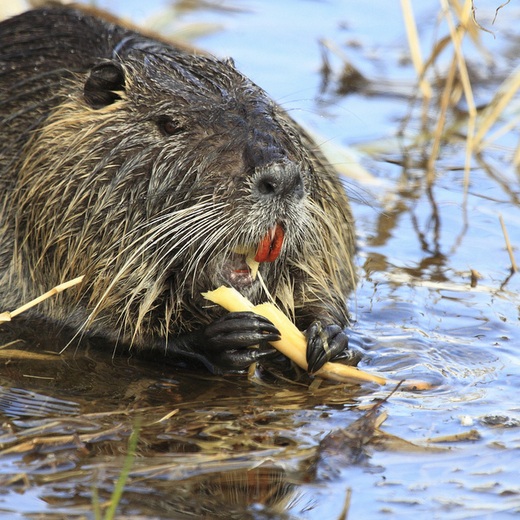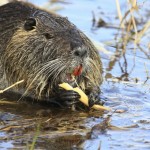What We Learned About Invasive Species While Drinking Beer

Courtesy of Dave Irving via Flickr Creative Commons
Feral hogs cause over $50 million in agricultural damage in Texas each year.
Monday night StateImpact Texas hosted an event called Invasive Species and Why We Love Them With Salt, part of KUT Austin’s regular Views and Brews: Conversations at the Cactus Cafe series. We took a look at the issues of invasive species in Texas (over beer) and examined some of the solutions on the table.
And one of the best solutions is to simply put them on the table. That’s the preferred option with one of the more destructive invasive species in Texas, feral hogs.
“How would I solve the problem?” posited hunter, forager and chef Jessie Griffiths of Dai Due Austin. “Tiger prawns, wrapped in feral hog bacon, and then grilled over mesquite.” Griffiths serves wild boar tacos at an Austin-area farmers market and leads hunts for feral hogs in northeast Texas.
“We try to use as much of it as possible,” Griffiths said at the panel. “At some point we’d like to get to 80 percent of our pork use from feral hog.” He said he’s also focusing on education, by teaching landowners what to do with trapped hogs. “Point A is a trapped hog,” he said. “Point B is dinner.”
Building a Market
John Davis, Wildlife Diversity Program Director at the Texas Parks and Wildlife Department, said that it’s important to draw a distinction between hunting and simply killing the feral hog for sport. “Unless you’re harvesting the animal, you’re not hunting,” David said. But he also expressed concern that if a market is created to put feral hogs on Texas dinner plates and restaurant menus, that could ultimately exacerbate the issue. “If there’s really a market for it, people may propagate the species to support that market, like cattle,” Davis said. “Then it becomes a problem.”
While for some the idea of eating feral hog is unappetizing, Griffiths said that once he started replacing the pork meat in his sausages with wild boar, his sales quadrupled. “There’s three million feral pigs in Texas,” he said. “Once people had it, they realized, hey, this isn’t a stretch. My kids will eat this.”
Griffiths also went into the rapid population growth of feral hogs. He said they reach sexual maturity in just six months. “Their gestation period is about 114 days. And the litter size is between eight and ten in good condition. Do the math. These things are exploding.”
But while feral hogs are ripe for harvesting and widely viewed as a public nuisance, John Davis of Parks and Wildlife said that with other species, it’s hard to get people to accept the fact that they need to be removed from the ecosystem. “It’s much easier to tell people we’re going get rid of Burmese pythons because a lot of people don’t like snakes. If it’s warm and fuzzy and people have gotten used to it, like feral cats, it’s much more difficult.”
Who Watches Out for Invasive Species?
“It’s very fractured,” Leslie Hartman, the Matagorda Bay Ecosystem Leader for Texas Parks and Wildlife. “In Texas, it’s Parks and Wildlife [and] some is the Department of Agriculture. It depends very specifically on what species you’re talking about.”
“People aren’t caught that often,” Davis of Parks and Wildlife said. “But introducing invasives, even intentionally, happens all the time.” He said that the English Sparrow and European Starling birds were both purposefully introduced by someone that wanted birds that had been mentioned in Shakespeare’s plays. Today’s feral hogs were introduced by Spanish explorers some 300 years ago. And some intentional introductions were even done by the government, as in the example of Kudzu. “We may not know they’re invasive until ten years from now,” Davis said.
For that reason, biological controls are typically the last resort for agencies like Parks and Wildlife when dealing with invasive species. “After chemical control, mechanical control, any other means first before biological control,” said Hartman of Parks and Wildlife. And the best way of dealing with them? “Prevention, prevention, prevention,” she said.
Hartman said that to that end, there are both state and federal lists of species prohibited from importation. “But unfortunately a new invasive is not going to be on that list, Hartman said. “So a lot of states try to do approved lists: you can bring it in and we don’t think it will be a big issue. But getting that through the legislature is always very difficult.”
Why Texas Has a Unique Problem
“I’ll try to be diplomatic here,” Davis of Parks and Wildlife said. “97 percent of Texas is privately-owned land. At the risk of admitting an embarrassment, we’re not real effective.” The issue is that Parks and Wildlife has very few lands where it can actively manage invasive species. “We have wildlife management property and we try to bring landowners in to educate them,” Davis said. “But the reality is, there’s a lot of land out there and we don’t know where things are.”
Texas Parks and Wildlife has a program called Texas Invasives that tries to get landowners to participate in monitoring and eradicating invasive species. “But we’re really not that successful,” Davis said. “We just don’t have the resources.”
We’ll have more up on the panel this week, including video. Thanks to everyone who came out or followed along on our Twitter feed, @StateImpactTX.


